Why Israel Should Have Gaza
The foundation of the modern Middle East has been broken from the start. Time, effort, and resources, beyond the immediate and basic humanitarian needs, should not be wasted on limited, stubborn ideas that will only lead to more tragic waste of human life. To break the cycle, a new foundation must be redrawn and built.
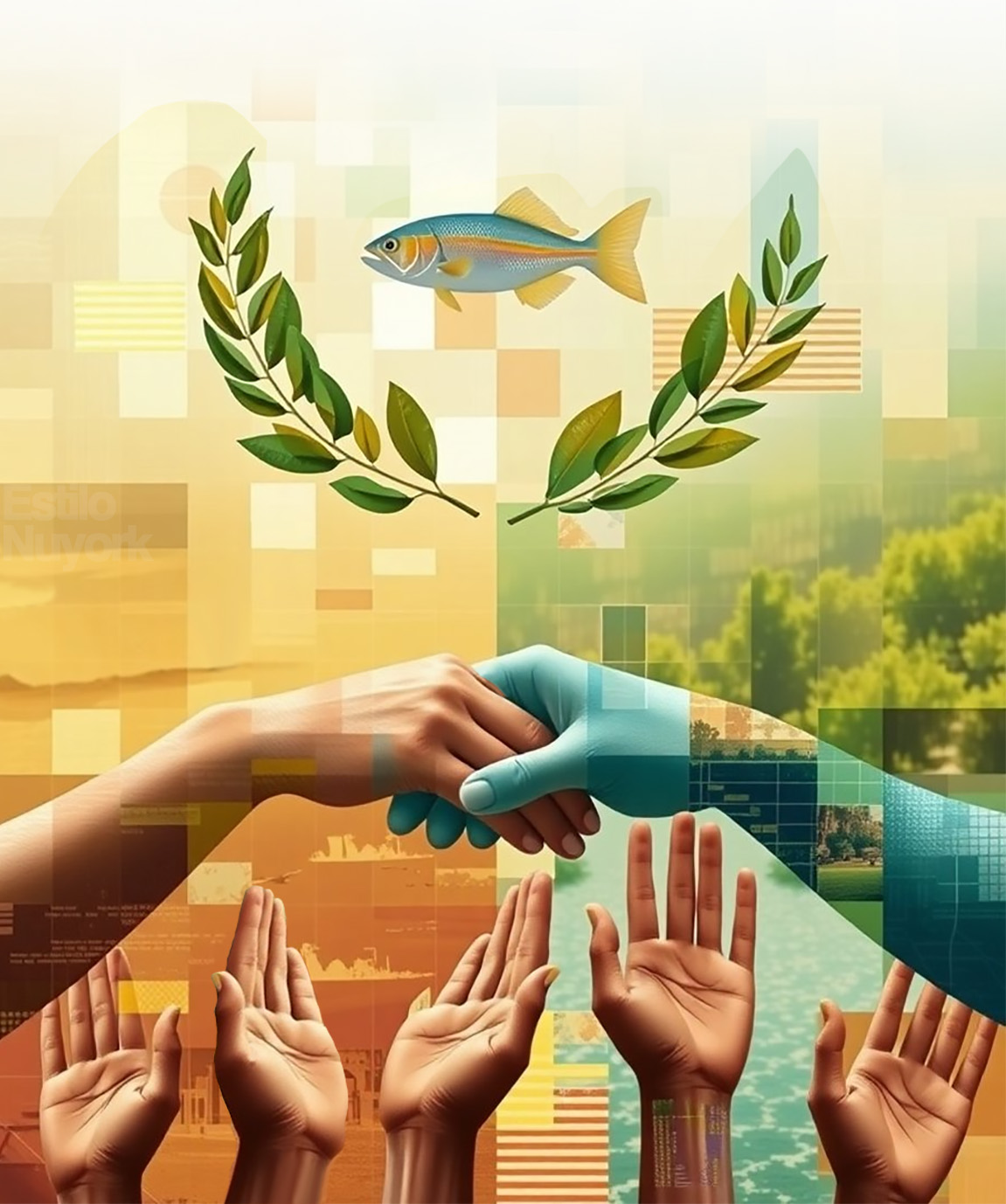
It takes a village. Seven hands representing seven nations of an alternate future where love and compassion redraw and re-engineer their borders to create and raise a new Middle East, one more prosperous than ever imagined before. The fish is many things to many cultures. Here, it is a new foundation. (Image: ENM)
“We are called to be God’s partners in mending the world.” — Rabbi Abraham Joshua Heschel
There is a place in an alternate universe somewhere, where peace in the Middle East becomes a real thing. In that place, Israel is greater, and the disappearance of all Palestinians—their erasure from maps and from memory—is not desired, nor the likeliest of outcomes. In that imagined world, only love and compassion are immovable, and the daughters, the sons, the grandchildren, nieces, and nephews are the ultimate priority. For them, we would move everything—our bodies, our borders, the earth, and the sea.
We have always been nomads and builders, exploring and settling new places. That is likely our nature in all the universes. And if our species survives here, we will keep exploring and settling across the stars. But we all deserve to be part of that journey.
Here, in our universe, the nature of our humanity is akin to pirate ships shooting at each other while caught in a maelstrom. That is essentially how we manage border disputes, resources, and foreign policy, as thousands of innocent people are killed over dirt and water, decade after decade.
Sometimes there are things you can ignore only for so long. To many outsiders around the world, conflict in the Middle East has become like white noise; some folks need it to go to sleep at night. But to others, the noise has reverberated for so many decades, it has created a mass effect, rippling across the planet. In some other place, the comfortably numb would awake in protest to the “troubles,” as the British would say, until the noise of hate and war would revert to the sounds of joy, and the roars of industry.
In the here, now, and all the yesterdays of most people living today, it has been an eternally horrible thing. What is the foundation of such a thing? How do we continue to devalue human life into the 21st Century, in the age of so much communication and intelligence? How do we destroy the potential to become better versions of ourselves and grow beyond earthly conventions? How do we squander, abuse, and discard so much, daily, and watch like voyeurs, addicted to horror, for decades?
“A new type of thinking is essential if mankind is to survive and move toward higher levels. The world as we have made it is a product of our thinking; it cannot be changed without changing our thinking.” — Albert Einstein
This conflict was spawned by a mutated virus of fear, hate, and violence brought by outsiders (as is usual the case in history) that has spread, compromising the capacity for love and compassion. As with any viral infection, as we have learned so well, it is important to find the source, so that a treatment or cure might be found quickly.
Peel Commission Partition Plan, July 1937. Areas enclosed within the red line were part of the proposed Jewish state. The black line with hatched area represents an “enclave” (or “corridor”) that was proposed as an international zone to remain under British control and administration, in recognition of Jerusalem’s religious and historical importance to Christians, Jews, and Muslims.
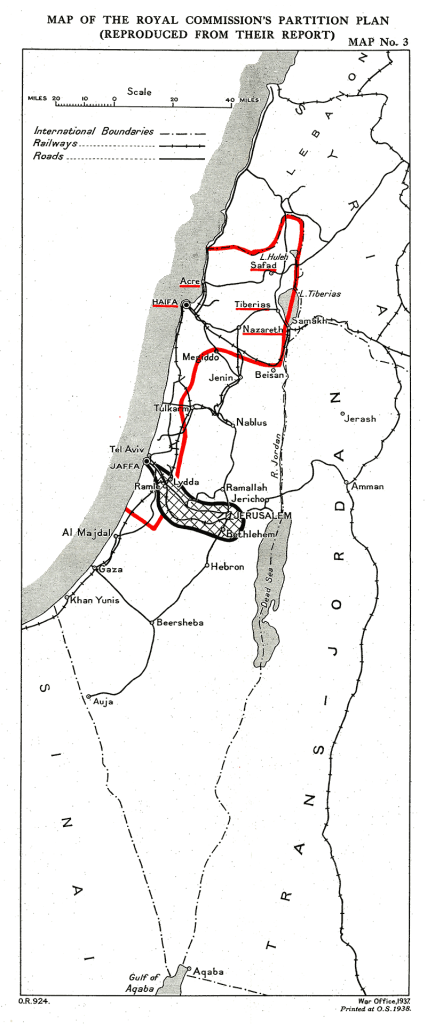
The affliction of terror in the Middle East did not originate from Jews nor Arabs, but from the architects of the United Kingdom, the League of Nations (later the United Nations), and other foreign actors, nearly a century ago. That is the lab from where the virus was cooked. The Middle East is their mess, and they should pay to fix it — not the Israelis, nor the Palestinians. Sure there were skirmishes between Jews and Arabs before the British, under the Ottoman Empire, etc., but nothing like what the world has witnessed in the last 80 years.
Before the outsiders began to carve up the place like drunk butchers, there was a chance at forming lasting peace. But they drew outside the lines. The problem was not creating a Jewish state in Palestine, it was about how the borders were drawn. That was the source of the mutation that would infect the region for decades to come.
The first formal attempt at drawing a Jewish state in Palestine was the 1937 Peel Report. That map showed slivers of rationale. Increasing Israel’s territory in the West Bank region and pushing the “Republic of Jerusalem” Mediterranean coastline further south would have given Israel significantly more territory, but no access to the Red Sea. That could’ve been fixed as well.
Was it post-war celebration hangover? After WWII, the Israel-Palestine map mutated into something incomprehensible that spawned decades of perpetual conflict. The only redeeming idea was Jerusalem remaining an independent territory.
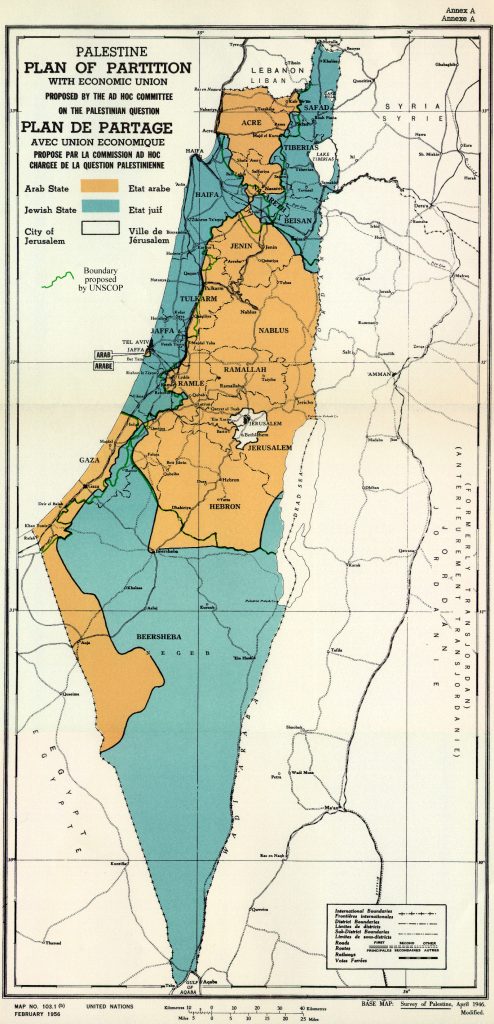
Here is where the mess begins. This was the United Nations Special Committee on Palestine (3 September 1947) and UN Ad Hoc Committee (25 November 1947) partition plan. The proposal was voted on in the resolution and adopted. Perpetual war ensued.
The new maps of Israel and Palestine started out not-so-great, and then went to bad, and worse. That is why there have been so many new maps and so much violence over the last 80+ years. They got the foundation wrong from the start, then kept building on it, like the Seaport Residences building at 161 Maiden Lane in Lower Manhattan. Just as that incomplete structure mars the storied New York City skyline, “Peace in the Middle East” became a bitter joke because the foundation has been wrong all along.
We can’t remain pirate ships caught in a maelstrom, shooting at each other forever.
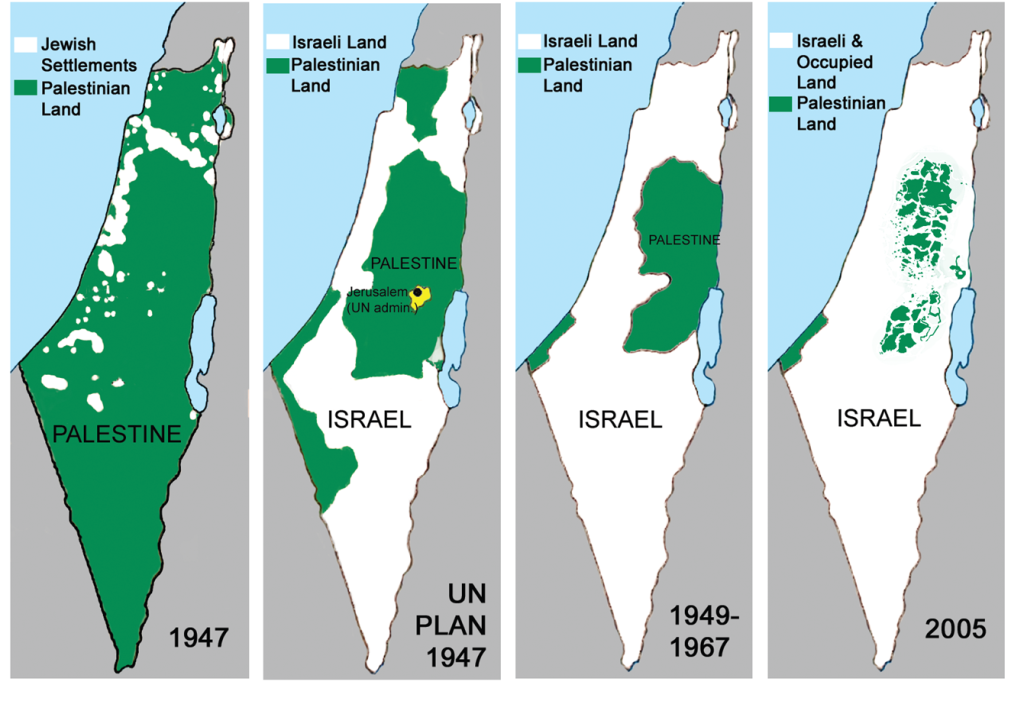
A nation disappeared, as the world watches. Was this part of the UK/UN plan in 1947? While some hardliners would prefer the extermination of Palestinians and the erasure of Palestine from all maps and history, others believe there is a better way.
Other than everyone initially hating the idea of redrawing borders, as much as mixing analogies of pirate ships, viruses, and leaning skyscrapers, this solution could nonetheless end decades of conflict and replace it with epic, world-class innovation and development. Although it exists in an alternate universe, nothing else seems like it could work long-term—other than the complete erasure of Palestinians and Palestine, which remains the likeliest outcome.
This is not only about permanently ending the most stubborn conflict of our times, but putting in its place a global effort to create something different: a new revolution for good, and a push toward levels of prosperity in the region never imagined before. Everything else is white noise.
Since the 1940s, all these great minds, with all their degrees, political skills, and negotiation savvy through time have led to kidnappings, killings, and forced displacement as normal tools of statecraft. It has been a journey of insanity and terror for too many innocent people for too long. In some far away place in another universe, the truly heroic and unprecedented element would be the human imperative to right the wrongs and to move on stronger and in better form to face all that is to come.
Sadly, the most ridiculous and absurd element about what follows, from this world’s perspective, is not the engineering or economics, but our capacity to redefine ourselves through love and compassion.
In an alternate universe somewhere, the political will required for sovereign governments and non-state actors to consider the following exists.
The Bahamut Solution: Remapping Peace in the Middle East
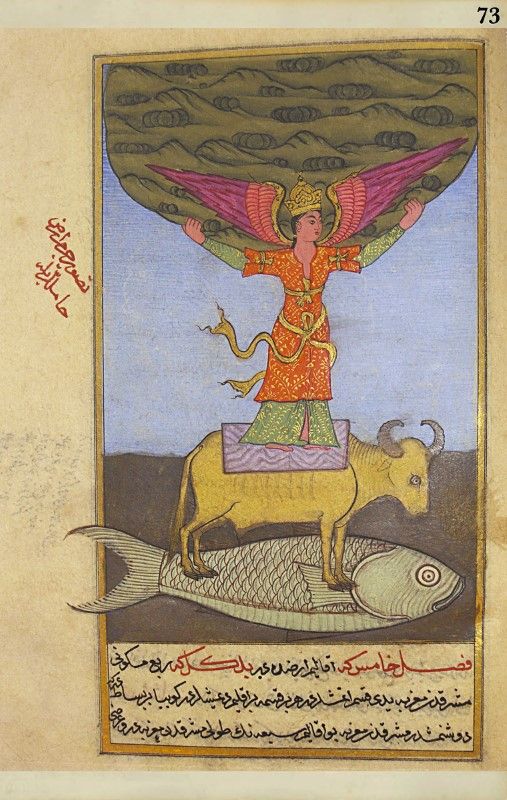
The fish (Bahamut) carries on its back the giant bull (Kuyuta), and on the green hyacinth slab stands an earth-bearing angel. — Surüri’s Turkish translation of al-Qazwini. Topkapi Palace Museum, Istanbul. “God created an angel who took [the earth] on his shoulders, and grasped it with his hands; the angel had as his support a rectangular rock of green hyacinth, itself borne upon a giant bull which rests upon a fish swimming in the water” (paraphrase of Qazwini i, 146, by Maximilian Streck).
The universe is constantly moving. We are literally spinning, spiraling, and streaking through space and time, faster each day. Even when we remove all the politics, solid foundations are essential to all things, to give us perspective, and for all things to sway and flow through all the spinning, spiraling, and streaking across the stars.
In the Middle East, however, every iteration to bring peace in more than 80 years has rested on the same fragmented, toxic, unstable ground—borders drawn in blood, betrayal, settlements layered over grievances, and promises unkept.
The Bahamut Solution represents a hard reset of the Middle East through a comprehensive yet relatively conservative remapping of borders, based on history, current events, settlements, and infrastructure in order to fix and reinforce the Middle East foundation. It also aspires, albeit in broad stroke format, to create an institutional foundation to make any transition as favorable as possible to all the affected citizens and businesses of the region first, especially war victims, as outlined in the Prerequisites that follow.
Some would view these ideas as radical, others as laughable, and most would dismiss it as delusional thought exercise. However, this plan would not involve forced displacement, kidnappings, nor exterminations of innocent women and children. In this scenario, the focus goes from survival to building prosperity for the future, instead of destroying lives based on past errors.
Although the foundation of the Bahamut Solution would be the redrawing of borders, it would have to begin with fundamental organizational restructuring in key areas. And even in an imaginary alternate universe, these would be broad strokes, very much understanding the seemingly infinite layers of details involved—for which the world has an abundance of experts for.
The Prerequisites
1. End of Hostilities, Disarmament and Dissolution of Non-State Militant Groups
a) Israel and Hamas end hostilities: All hostages are released, and all war victims are given aid and proper shelter as needed with UN peacekeeping forces assisting.
b) Disbandment of Hamas: Hamas would be fully disbanded as a military and political entity with the ratification of the new Palestinian state. All weapons and materials would be surrendered to a UN peacekeeping force to be recycled to the provisional Palestinian government’s police and defense forces.
c) Integration of Hezbollah’s Military Wing: Hezbollah’s military wing would be disbanded and fully integrated into the Lebanese Armed Forces, ending its status as an independent non-state actor upon the ratification of the new Palestine territory between northern Israel and southern Lebanon.
2. Mutual Recognition and Sovereignty Agreements
Israeli-Palestinian Mutual Recognition: Israel and Palestine would formally recognize each other’s right to exist as sovereign states, as allies, and as protectors of the people within the newly defined borders. Neighboring states (Egypt, Jordan, Lebanon, Syria, and Saudi Arabia) would acknowledge these borders as final and legally binding. This agreement would be ratified by the United Nations and other state and multinational bodies.
3. Security and Peacekeeping Frameworks
a) US Naval Presence: A temporary US Amphibious Ready Group (ARG) with a Marine Expeditionary Unit (MEU) would be stationed in the Mediterranean near Gaza, in coordination with Israel and Egypt, to ensure stability during disarmament and transition.
b) Expanded UN Peacekeeping Mission: The UN Truce Supervision Organization (UNTSO) would be expanded and mandated to manage:
- A temporary disarmament mission to oversee Hamas and Hezbollah demobilization.
- A permanent Jerusalem border force to patrol the new city-state’s demilitarized zone.
- A permanent Middle East Water Administration (MEWA, see 3. c) below) protection brigade to safeguard inland water sources, projects, and the Crown of Aqaba bay (By State and Area, 8., below).
3. International Financial and Development Institutions
a) Establishment of the Middle East Bank (MEB): A supranational central development bank would be created and funded by a coalition of nations led by the UN, UK, US, EU, Egypt, Saudi Arabia, China, and regional states for specific missions, programs, and projects. Initial funding would be $500 billion (in 2025 dollars) to finance affected citizens’ basic and transition necessities, security, select existing and new infrastructure works, temporary and permanent housing, and territorial compensation agreements. Funding would be released in tranches tied to verifiable milestones: (e.g.) 20% upon Hamas/Hezbollah disarmament (verified by UNTSO), 30% after border ratification by all states, 50% after Jerusalem City-State operationalization. The UN/UK/EU/US contribute 60% of seed capital—but Saudi Arabia, and Egypt hold veto power over disbursement, aligning incentives with regional stakeholders. China would have veto power over water projects and rail investment, within respective agreement frameworks. This institution would have a mandatory 20-year mission to oversee regional restructuring, citizen security and mobilization, and infrastructure projects, with options to extend in 5-year blocks, or until proper transfer of responsibilities to state and regional organizations.
b) Citizens First Security and Relocation Administration: This body, under the MEB, UN oversight, and in cooperation with all regional state governments, would manage population transitions, offering affected residents and settlements multiple options:
- Relocate with full compensation (funded by MEB) and comparable housing guarantees. Temporary/long-term housing from prefabricated structures, repurposed shipping containers, and other suitable temporary/long-term structures and basic services would form part of the first phase of relocation if more permanent settlement is not immediately available, but the need to relocate is immediate.
- Remain in situ under original citizenship with special protected resident status and guaranteed basic necessities.
- Remain with dual citizenship with country of origin and new border country (Israeli-Palestinian or other), in cooperation with respective states, and new border agreements.
c) Middle East Water Authority (MEWA): A regional water management body governed by a board representing Israel, Palestine, and Jordan, with UN backing. MEWA would oversee all shared inland water resources, including the Sea of Galilee, Jordan River, Dead Sea, and Gulf of Aqaba bay. Its mandates would include:
- Maintaining quality and quantity levels in the Sea of Galilee, rehabilitating the Jordan River, and stabilizing the Dead Sea.
- Assessing, assisting, accelerating, and expanding existing water projects in the MEWA jurisdiction.
- Managing new desalination plants and maintaining equitable water distribution according to established guidelines and mitigation protocols.
- Negotiate new commercial lease for salt evaporation ponds between Dead Sea Works and Palestine.
- Enforcing environmental protections, security, and traffic safety in the Gulf of Aqaba’s “Crown of Aqaba” bay zone.
d) Multinational Civil Engineering Division: A temporary body under the Middle East Bank would coordinate infrastructure repairs, changes, and construction related to new borders, including housing construction, pipeline extensions, airport relocations (e.g., Taba and Ramon airports), and MEWA construction projects (desalination plants, water pipe laying, etc.). Directives would aim for zero disruption to established settlements and communities in all affected areas.
e) Regional Labor Commission: A multinational body under the MEB would coordinate and manage the immense labor needs for all connected projects and missions. The body would be mandated to choose existing regional experts first for leadership, management, and general labor. Salaries would be established by the Commission according to established guidelines and MEB guidance.
f) International Oversight Coalition: A neutral coalition of states (e.g., Senegal, Switzerland, Singapore) would monitor implementation fairness. The UN Security Council, Arab League, and EU would jointly guarantee treaty compliance and MEB solvency.
6. Jerusalem City-State Agreement
Jerusalem as a Sovereign City-State: UN trusteeship over only holy sites (Al-Aqsa, Western Wall, Church of Holy Sepulchre) for 5 years, with Israeli security and Palestinian custodianship. Phase 2: Transition to city-state only after joint police training and settler relocation. This follows the 1995 Hebron Protocol model—where Israel/Palestine shared security in sacred spaces before broader talks. Phase 3: Jerusalem would become a demilitarized, internationally guaranteed sovereign entity governed jointly by Israeli and Palestinian boards of governors. The joint government would command the civil police of the interior of the city-state. A joint judiciary would interpret and maintain Jerusalem City-State law. Both Israel and Palestine would have the option to house the seat of their governments within their respective missions to Jerusalem.
In addition:
- Major religious institutions (e.g., Al-Aqsa Mosque, Church of the Holy Sepulchre) would continue to be protected under established standards.
- Headquarters for MEB, MEWA, Engineering Division, and Citizens First Administration.
- A permanent UN peacekeeping mission to protect borders and ensure neutrality.
These and other institutional foundations would enable the core territorial restructuring that follows.
What’s one more map? To redraw the Middle East in a way that it takes into account decades of disputes, settlements, infrastructure, nuclear research facilities, and centuries of history, required a good deal of research. In this Google Map, you can zoom in and out, drag around, and click on the colored layers for more information.
By State and Area
1. Israel
Territorial Adjustments:
- Total territory area, Mediterranean coastline, and Gulf of Aqaba coastline would be expanded, creating a larger, more streamlined Israel border.
- Western portions of Judaea and Samaria (West Bank) ceded to Israel, increasing distance between Tel-Aviv and new Palestine border by over 20 kilometers.
- Gaza and Gaza Marine gas fields ceded to Israel, maintains current development and profit sharing arrangement with Palestine and Egypt. All Gaza Marine revenues flow into a UN-administered escrow account, with withdrawals requiring dual approval from Palestine and Egypt. Israel receives a 5% management fee for infrastructure maintenance—but zero discretion over funds. This mirrors the Iraq Oil-for-Food Program (1996–2003), where neutral oversight prevented diversion.
- Gain of approx. 13 kilometers extension into the Sinai, from southwest corner of Gaza to Taba on the Gulf.
- Israel cedes approx. 15-20 kilometer wide strip east of the current Jordan border below the West Bank to Palestine.
- Israel cedes a small portion of the northern border to Palestine.
- Israel returns Golan Heights to Syria (Israeli settlers covered under Citizens First program).
- Sea of Galilee shared with Palestine, but management under MEWA.
- The Dead Sea salt evaporation ponds would continue to operate under new commercial license between Israeli Dead Sea Works and the Palestinian government.
- Israel gains Taba airport in territorial expansion with renovation funding.
Israel would have a co-administration role in Jerusalem City-State, and would be a managing partner in the MEWA, Citizens First transition team, and Civil Engineering Division. Israel receives construction funding for “Crown of Aqaba” eco city, renovation of Taba airport. Israel secures more defensible borders while gaining long-term security assurances, normalization with all neighbors, and full, uninterrupted access to all current and future water and power systems which may fall under new border or new agreements.
2. Palestine
Territorial Adjustments:
- A sovereign and contiguous Palestine is created by ceding Gaza (retaining current gas field development agreements. See above: 1. Israel • Gaza) and western portions of the West Bank to Israel in exchange for Israeli and Arab land concessions and international recognition. A new Palestine would stretch from the Mediterranean, between Israel and Lebanon, around the Sea of Galilee between Israel and Syria, and run down between Israel and Jordan to the Gulf of Aqaba.
- Joint administrative presence in Jerusalem City-State with option to locate seat of government within mission property.
- Managing partner in the Middle East Water Authority.
- Priority labor placement within existing and new infrastructure projects via Regional Labor Commission.
- Railway construction (UIC standard gauge) funding via Middle East Bank and China investment.
- Guarantees: Water-sharing, land swaps, full recognition by Israel, Arab League, US, and UN.
Palestine gains true sovereignty, economic backing, mobility through new water access, a railway project, and airport, reducing dependency on Israel while securing stable borders.
3. Egypt
Territorial Adjustments:
- Northeastern Sinai corridor ceded to Israel, including Taba, to accommodate new Palestine eastern border.
- Gains: Direct land and infrastructure compensation and investments from MEB, regional trade leverage, construction funding of new airport in the Southern Sinai and “Crown of Aqaba” eco city phase, and a board seat on the Middle East Bank.
- Guarantees: Preservation of sovereignty outside the designated zone.
Egypt’s strategic role as gateway between Africa and the Levant expands. The Southern Sinai gains new prestige through “Crown of Aqaba” eco-city and infrastructure funding, and new airport.
4. Jordan
Territorial Adjustments:
- Gains land in southern corridor, including approx. 7km of additional coastline in the Gulf of Aqaba; cedes a smaller portion of territory near the Sea of Galilee to widen Palestine passage.
- Jordan is partner in MEWA oversight, and infrastructure investments.
- Jordanians of Palestinian descent assured permanent status and dual-citizenship options under Citizens First program.
Jordan strengthens its internal stability while gaining economic lifelines, increasing coastline in the Gulf, new governing authority in billion-dollar regional water authority, removes long-standing demographic pressure points.
5. Saudi Arabia
Territorial Adjustments:
- Cedes small sliver of territory in the northwest to Jordan to adjust new Palestine border.
- Regional partner in the Middle East Bank with co-funding influence, full normalization with Israel.
- Additional compensation for NEOM integration.
Saudi Arabia secures influence in the region’s financial and logistical core while finally unlocking full-scale normalization dividends.
6. Lebanon
Territorial Adjustments:
- With combined Israeli ceded territory in the north, Lebanon cedes small portion of territory in the south to give Palestine new Mediterranean coastline. In exchange, Lebanon gains territory in the east, and an expanded northern Mediterranean coastline, both through Syrian cooperation.
- Lebanon receives investment packages for reconstruction and energy integration through the MEB framework.
- Guarantees: Hezbollah transition package into political-only entity funded by MEB, monitored and facilitated by UN peacekeeping forces.
Lebanon receives stabilization tools and reconstruction funds in exchange for de-escalation, new Palestinian border, and a permanent end to proxy conflict.
7. Syria
Territorial Adjustments:
- Golan Heights officially returned to Syria.
- Southern portion of Golan Heights ceded to Palestine with MEB compensation. Syria keeps northern portion of Golan Heights.
- Reconstruction guarantees post-conflict, and MEWA integration for Euphrates–Jordan river cooperation.
- Syria cedes two small western portions of territory to Lebanon. These lands to be compensated by the MEB and covered under the the Citizens First program.
- Syria receives MEB funding for Al-Yarmuk river rehabilitation, to be managed via MEWA.
While Syria makes land concessions to Lebanon to help create new Palestine borders, it gains in total land area. Syria also gains development funds and fast-track reintegration into the regional economy, ending decades of frozen conflict.
8. The Crown of Aqaba
Territorial Designation:
- The Gulf of Aqaba bay area would become a special protected development zone.
- Eco-cities, built in phases with first phase funded by MEB, on each national partition of the bay, would form a symbolic “crowning” achievement of a re-engineered foundation to a new Middle East.
- Water quality control, and security would be maintained by UN-backed Middle East Water Authority.
The bay that connects five nations in the Middle East would become a new world destination for tourists and businesses looking to engage a new, modern, and unified Middle East.
A Future Beyond Conflict
In this universe, to realize such a vision would require a deliberate, calculated, and courageous step onto a new path—”a new type of thinking.” It would insist that the geography of conflict must be dismantled before a geography of hope could rise.
This proposal would offer a conceptual re-engineering of a broken foundation, the institutions to lay concrete, and an international guarantee to safeguard the structure until it could stand firm. It would be the design for a neighborhood improvement district where Israel and Palestine could dwell under separate roofs, sharing secure and prosperous lands and waters.
The old curses plaguing this land—theft, occupation, terrorism, perpetual war—are not its destiny; they are choices. The Bahamut Solution would present another choice, another alternative, one that would ask more of us now but promise a finality all prior plans have failed to deliver—and would continue to fail—until Palestine vanishes from history. This, or something akin, could stand as a testament to our humanity, proving that the most realistic path would not be one of managed conflict or erasure, but one bold, open, and capable enough to respect human life, cultures, and history, and embracing love and compassion. Somewhere in the universes, we have such capacity.
In this exercise, the prerequisites would be steep, yet the cost of inaction would carve an indelible wound on our collective soul. In this world, the future should not be ours to merely witness; it should be ours to build and protect for all.
More on the roots of the decades-long Israel-Palestine conflict:
The renowned historian Avi Shlaim recounts the roots of the Israel-Palestine conflict. He is interviewed by Karan Thapar.
In this segment of Office Hours with Dr. Roy, the roots of the Israel-Palestine conflict are laid out in the sometimes controversially succinct style Dr. Roy Casagranda is known for.

